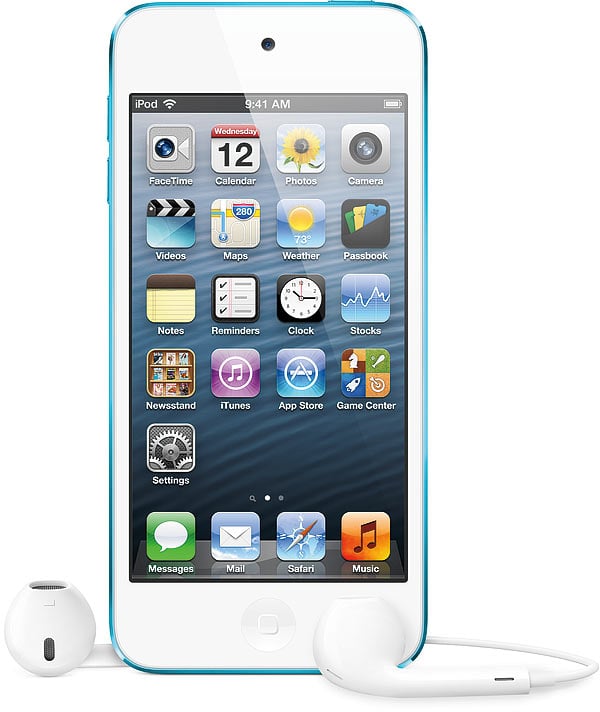Home Donate New Search Gallery Reviews How-To Books Links Workshops About Contact
iPod Touch Audio Quality
5th Generation ("5G," 2012-)
© 2012 KenRockwell.com. All rights reserved.
Apple iPod Touch, 5th Generation, blue version (5 megapixel camera, 3.3mm f/2.4 lens, 1,134x640 16:9 display, 3.1 oz./87 g). My biggest source of support is when you use any of these links, especially this link directly to them all at Amazon, when you get anything, regardless of the country in which you live. Thank you! Ken.
January 2013 Apple Reviews Audio Reviews All Reviews
Overview
I'm discussing the iPod Touch 5G's sound quality for playing music via the iPod Touch 5G's Music app as heard at its 3.5mm jack, either with headphones or plugged into a hi-fi.
I'm not discussing the built-in speaker's performance.
If you ask, the built-in speaker is pretty tinny, but works.
Perceived Sound Quality
Plugged into professional monitoring equipment as a sound source, the iPod Touch sounds great. Be sure to make good music transfers, and leave the iPod Touch's level set to maximum, and just plug it into your hi-fi. Wasting time with "Audiophile" DACs and other fluff usually degrades the sound more than just using the self-powered iPod Touch 5G directly as a source.
Used directly with headphones plugged into the 3.5mm jack (use the Grado adapter for real headphones with 1/4" plugs), it also sounds swell so long as its usual 1V RMS maximum output is enough. It even sounds swell with the Audeze LCD-3, with which it goes plenty loud. It's plenty for 32 Ω headphones, but for classical music with 600 Ω headphones, might not be. No problem, just add a great headphone amplifier like the Woo Audio WA7 if you need more headphone output.
There isn't much difference between different iPods, iPhones and iPads; all pretty much have ultraflat response, near-zero output impedances and deliver 1 V RMS full-scale. People who hear huge differences in bass or treble aren't comparing them competently, or are comparing the internal speakers or something else.
I have not performed my Acid Test where I A/B the iPod Touch 5G's output playing a CD recorded via iTunes as an ordinary AAC file versus a real, dedicated CD player playing the same physical CD, but when I did spend several hours A/Bing an iPod Touch 4G with 160 kbps AAC VBR files against the original CDs, I wasn't able to hear any difference at all as monitored with a STAX SRM-T1 amplifier and STAX SR-007 MK II electrostatic headphones. (MP3 files sound much worse at the same data rates, I'm not talking about them.)
This setup lets me hear everything, like the shape of the room in which the recording was made, and I couldn't hear anything different after several hours of careful listening, much less better or worse, between a 25-pound dedicated CD player and the same CD played out of my iPod Touch 4G as coded and compressed via iTunes – and I can hear a quarter decibel level shift, I can hear 0.1 % THD, and I can hear -2dB drop at 20 cps. Unlike old audio reviewers, my hearing still tests perfectly. I can hear every page turn, every seat creaking, I hear the conductor humming, the soloists breathing and I hear fingers hitting the keys or frets in these recordings, but all I heard when A/Bing was exactly the same thing out of each when I flipped my A/B switch. Even the shape of the room was unchanged, something you can't even hear in most conventional hi-fi systems.
Of course it is very difficult to setup such a test with the levels and timing matched, but when you do, the whole iPod audio ecosystem is transparent. If you're hearing differences, you just don't have everything matched; most CD players need a 6 dB pad to match the iPod Touch's output and you have to get both players in perfect sync and have an instantaneous A/B switch, otherwise your test will be showing the limits of your test system and not differences between your CD player and the iDevice.
I suspect the iPod Touch 5G will also pass the Acid Test; in any case, it sounds great subjectively as a source.
Audio Quality Measurements
I used a $50,000 Rohde & Schwarz UPL audio analyzer to perform these measurements.
The traces are color coded for the Left Channel and for the Right Channel. When they don't lie on top of each other, it's due to channel imbalance.
I loaded the CBS CD-1 standard test CD into iTunes as ALC files, synced my iPod Touch 5G via iTunes 10, and then played-out from the iPod Touch 5G's standard Music app at maximum gain (volume) under battery power.
Output Voltage
Load |
0 DBFS @ 1 kHz |
200 kΩ |
1.0371 V |
600 Ω |
1.0347 V |
37.5 Ω |
1.0026 V |
Output Source Impedance
1.4 Ω, including my cheap cables.
Output Noise Levels
-106.8 dBV, A-weighted, playing zeroes (silence).
-120 dBV, A-weighted, idle.
Frequency Response
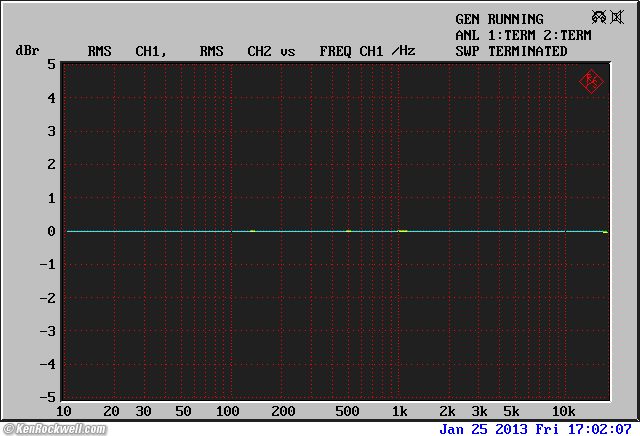
iPod Touch 5G Frequency Response, 200 kΩ load, 1 V RMS output.
As expected, the iPod Touch 5G's response is ruler-flat.
Let's expand the scale and look more closely:
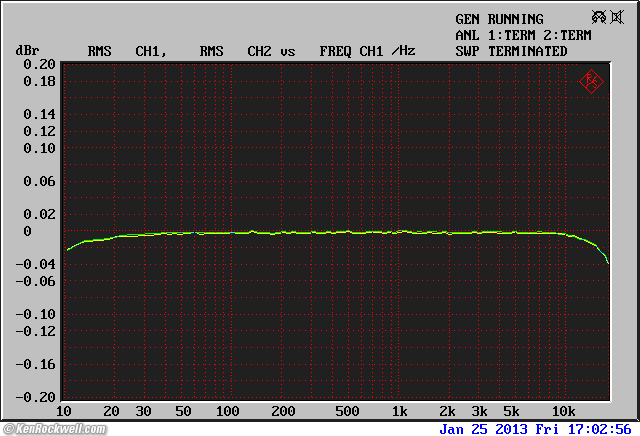
iPod Touch 5G Frequency Response, 200 kΩ load, 1 V RMS output, expanded scale.
Not bad; down only 0.005 dB at 20 Hz and -0.04 dB at 20 kHz, flatter than most labs can measure and twice as flat as the iPhone 5.
Let's plug in a headphone and see what happens:
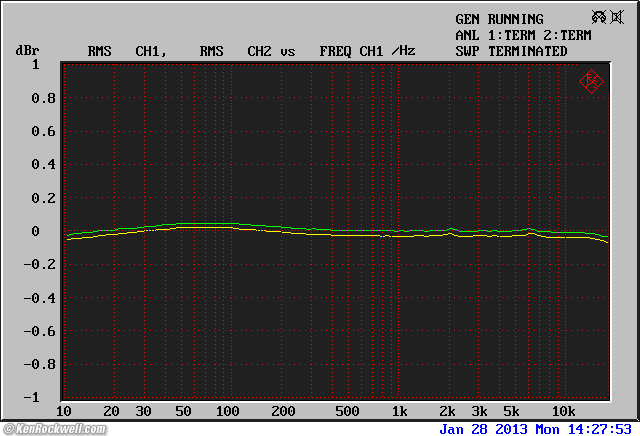
iPod Touch 5G Frequency Response, driving Ultrasone Edition 8 (32Ω).
The near-zero (<1.4 Ω) output impedance of the iPod Touch 5G is much better (lower) than most dedicated headphone amplifiers, even most exotic audiophile amps, and therefore its response is not significantly affected by the headphones in use. Most dedicated amplifiers have about twenty times the output impedance of the iPod Touch 5G, and allow about a dB or two of false bass boost with the Ultrasone Edition 8. With the iPod Touch 5G, the sound is accurate and well controlled.
Since the iPod Touch 5G's output impedance is one-third that of the iPhone 5, it allows even less variation in frequency response, but neither has enough to worry about.
Total Harmonic Distortion
This is true THD only, which includes harmonic components only and ignores non-harmonic content (noise):
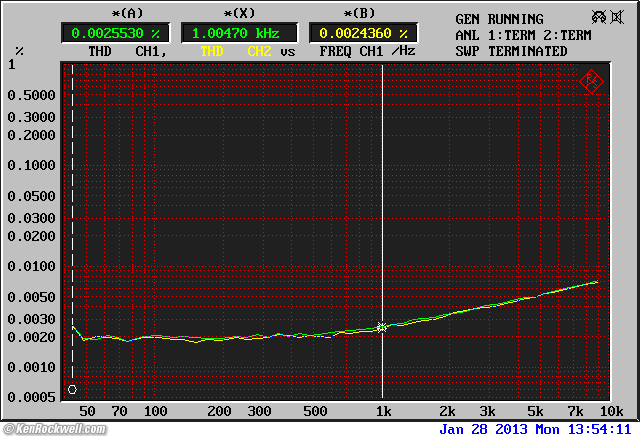
iPod Touch 5G THD, 1 kHz, 200 kΩ load, 1 V RMS.
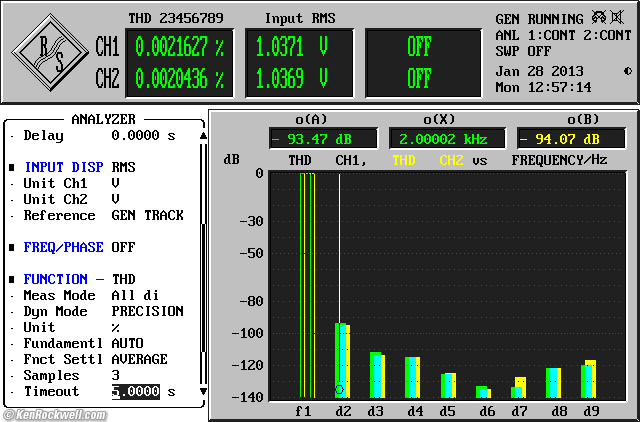
iPod Touch 5G Harmonic Distortion Spectral Content, 1 kHz, 200 kΩ load, 1 V RMS.
To my surprise, the harmonic content is mostly second-order, with higher harmonics at least about 15 dB down from the second harmonic. I'm more used to seeing this sort of signature from tube amplifiers!
The distortion lowers if you lower the volume setting:
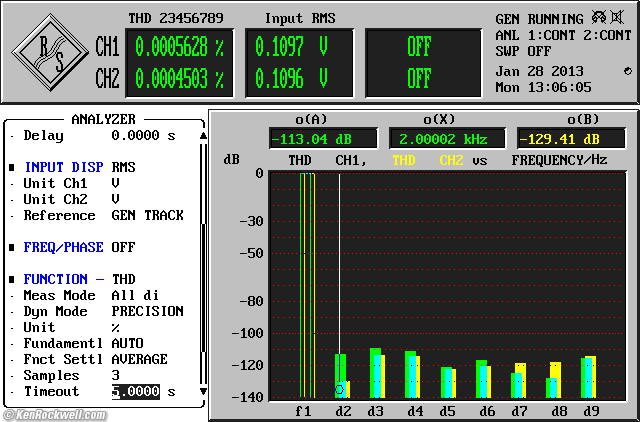
iPod Touch 5G THD, 200 kΩ load, 100 mV RMS output at 0 DBFS (gain at -20 dB or about one-half volume).
Let's see what happens if we drive a 37.5Ω resistor as a load:
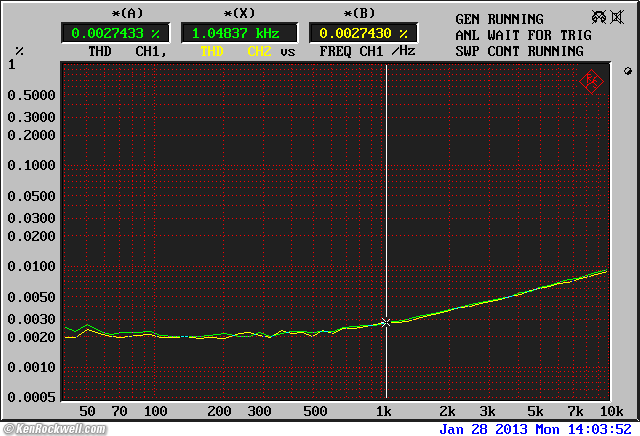
iPod Touch 5G THD, 37.5 Ω load, 1 V RMS.
Again no problems. There's a tiny bit more distortion as expected, but nothing significant.
OK, enough of driving resistors, which represents what happens when you plug the iPod Touch 5G into hi-fi gear as a source.
Let's start plugging in real headphones and see how it performs driving real 32 Ω loads, which are measurements you'll almost never see elsewhere:
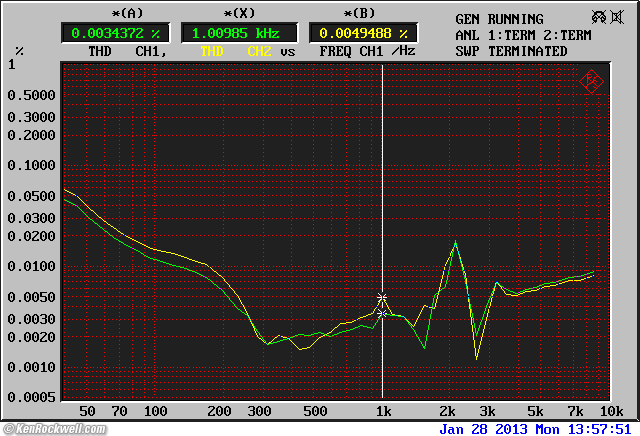
iPod Touch 5G THD driving Ultrasone Edition 8 (32Ω), 1 V RMS.
AHA! Now we have distortion while driving a real, tough but typical 32 Ω headphone load. But wait: this is at full volume, and at this level, the headphones were generating far more distortion out of their own distress (not shown here) than any distortion of the electrical signal!
Compared to most dedicated audiophile amplifiers, the iPod Touch 5G still drives the Ultrasone Edition 8 with less distortion — and this is at a deafening 1V RMS (113 dB SPL) to which I haven't pushed other amplifiers driving 32 Ω headphones.
Let's look at the harmonic content when pushed this hard at 61 Hz:
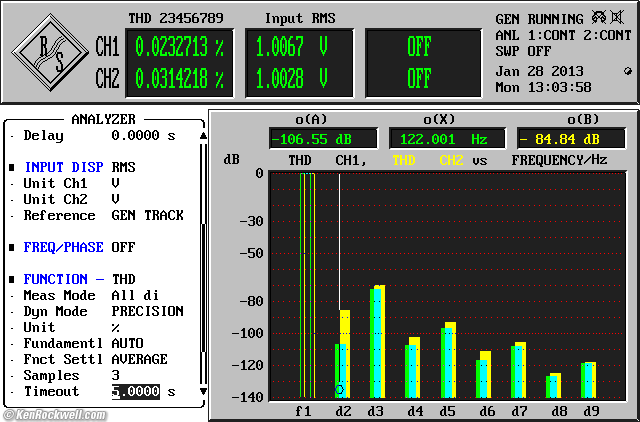
iPod Touch 5G THD driving Ultrasone Edition 8 (32Ω), full output at 0 DBFS at 61 Hz.
Mostly third harmonic at about 0.03% (-70 dB), but the headphones themselves were hideously distorting far more than that at 61 Hz from their own mechanical limitations (not shown).
Conclusion: the iPod Touch 5G's own distortion is insignificant compared to the distortion of the headphones themselves at this insane level in the bass.
Let's bring it down from deafening (113 dB) to merely too damn loud (93 dB SPL), with a 100 mV signal. In other words, I turned the iPod Touch 5G's volume down from FULL to about halfway:
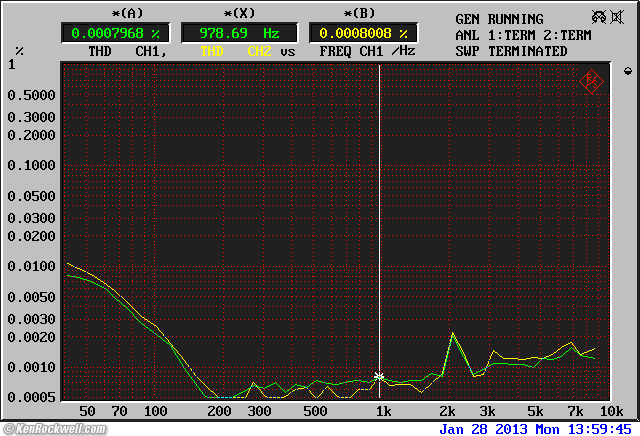
iPod Touch 5G THD driving Ultrasone Edition 8 (32Ω), 100 mV RMS output at 0 DBFS (gain at about -20 dB or about one-half volume).
AHA! As expected, much less distortion, and far less than most exotic dedicated headphone amplifiers at low frequencies (see my other audio reviews) when driving real 32Ω headphones.
Peak Overload Capacity
Real music never has this problem, however we can generate pathological test signals which can overload less able audio equipment whose designers misunderstand how analog signals map when sampled, quantized, and then played back. In other words, transient signals can and should exceed the 100% level of a sine wave at full scale.
This still has never mattered with real music, but with some of the overlimited, over compressed and composite-clipped crap getting mastered onto CDs by deaf producers who think music buyers prefer the loudest, as opposed to the best, music, many popular CDs today (and therefore also the LPs, CDs and SACDs mastered from the same files) are already recorded with distortion and overloads never considered when the CD and digital audio was first designed back in the 1970s, which can stress weaker playback chains.
Let's see how the iPod Touch 5G handles this overload, specifically with a pathological 100% square wave signal that excites full ringing. Ideally the output should be a square wave with only odd-ordered harmonics, and no even-ordered harmonics. Let's see:
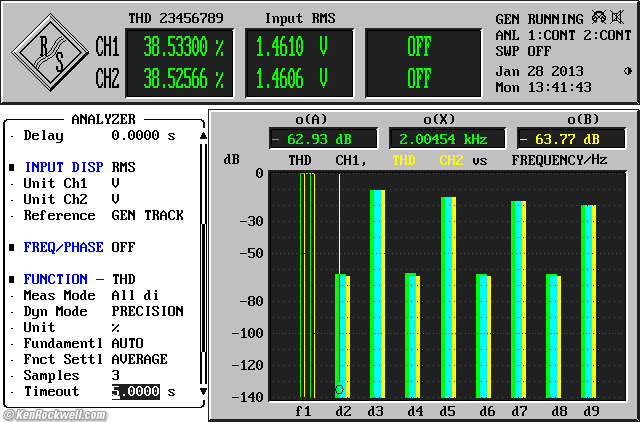
iPod Touch 5G Harmonic Distortion Spectral Content, 1,002.27 Hz Square Wave, 200 kΩ load, CD-1 track 16.
Bravo! Even-order harmonics are way down; no need to worry about playing crappy music at full level when using the iPod Touch 5G as a music source for your hi-fi. The iPhone 5 is a little better here, but not enough to worry about.
Jitter
Below is a devious test I devised that shows actual digital jitter as detected in the analog output. This is a very narrowband FFT of a 10,007 Hz sine wave.
Ideally it's just one spike, and any jitter is seen as a risen skirt or spikes around it:
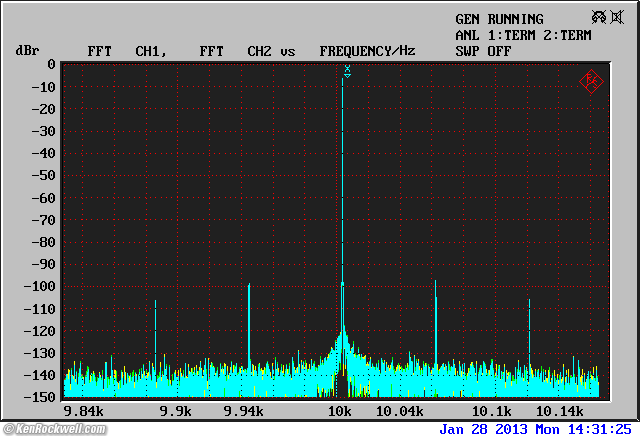
Narrowband FFT of 10,007 Hz sine wave at full scale, 200 kΩ load, CD-1 track 9.
This is pretty good, as expected. Unlike external DACs which all pick up jitter as noise enters interconnects and confuses the clock recovery circuitry, CD players and iPods all use their own internal original clock signals to drive their DACs. In other words, one-box players never need to recover a clock because they still have it, while TOSLINK and SPDIF and USB all have to try to recreate the lost clock signal because those interfaces lack a dedicated, parallel clock signal connection.
In any case, the overall skirt is quite low, as good as a real CD player and better than many external DACs, but the individual spikes are a little higher.
I wouldn't worry about any of this; all these spikes are completely inaudible in the presence of the 10 kHz sine wave of which they are part (as the 10 kHz sine wave jitters it changes frequency), with the 10 kHz sine wave still 90 dB louder than any of the nearly identical (in frequency) spikes.
Summary top
Confirming what I hear with critical listening, the iPod Touch 5G is a wonderful high-fidelity audio source. While publications funded mostly by advertisements from makers of expensive cables, power conditioners and outboard DACs don't want you to know this, the iPod Touch 5G is a better audio source than most DACs will be when connected to a computer or CD transport. The only difference is that the iPod Touch has a level 6 dB lower than a proper CD player, but the iPod Touch still has more output at 1 V full-scale than some outboard audiophile DACs! (Stereophile wrote that "The iPod's measured behavior is better than many CD players" back when the iPod first came out and was only considered as a toy and not as a better player than most of the exotic fluff gear out today.)
The iPod Touch lacks a fan or hard drive, so it runs silently as it plays from its buffered solid-state memory.
The iPod Touch 5G has the additional benefits of being self-powered, so you have no ground loops as you will when using AC-powered gear or anything connected to a computer via a electrically conductive cable.
Compared to the iPhone 5, performance is almost identical, with the iPod Touch 5G measuring a little better at most things, but only in ways so subtle that only a laboratory analyzer could measure the difference.
The lower output source impedance of the iPod Touch versus the iPhone 5 would only matter if you're crazy enough to be trying to drive 8Ω speakers directly, which although I haven't tried with these iDevices, the iPod Touch will probably go a little louder than the iPhone.
Ignore those who confuse the iPod Touch with crappy MP3 players; the iPod Touch has wonderful audio quality for serious music listening either directly with good or great headphones or plugged into the rest of your high fidelity system.
Enjoy your iPod Touch!
Help me help you top
I support my growing family through this website, as crazy as it might seem.
The biggest help is when you use any of these links when you get anything, regardless of the country in which you live. It costs you nothing, and is this site's, and thus my family's, biggest source of support. These places have the best prices and service, which is why I've used them since before this website existed. I recommend them all personally.
If you find this page as helpful as a book you might have had to buy or a workshop you may have had to take, feel free to help me continue helping everyone.
If you've gotten your gear through one of my links or helped otherwise, you're family. It's great people like you who allow me to keep adding to this site full-time. Thanks!
If you haven't helped yet, please do, and consider helping me with a gift of $5.00.
As this page is copyrighted and formally registered, it is unlawful to make copies, especially in the form of printouts for personal use. If you wish to make a printout for personal use, you are granted one-time permission only if you PayPal me $5.00 per printout or part thereof. Thank you!
Thanks for reading!
Mr. & Mrs. Ken Rockwell, Ryan and Katie.
Home Donate New Search Gallery Reviews How-To Books Links Workshops About Contact

